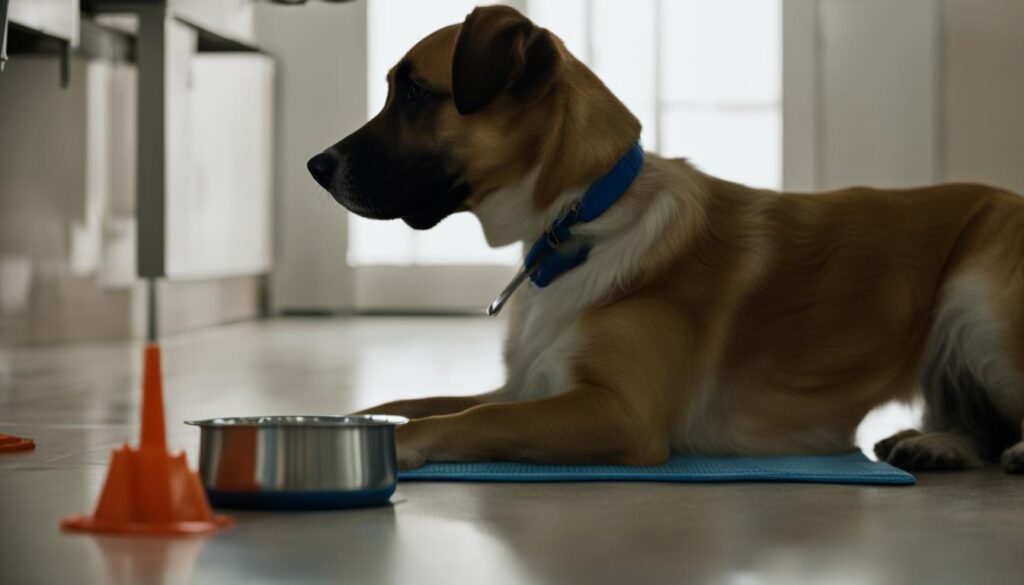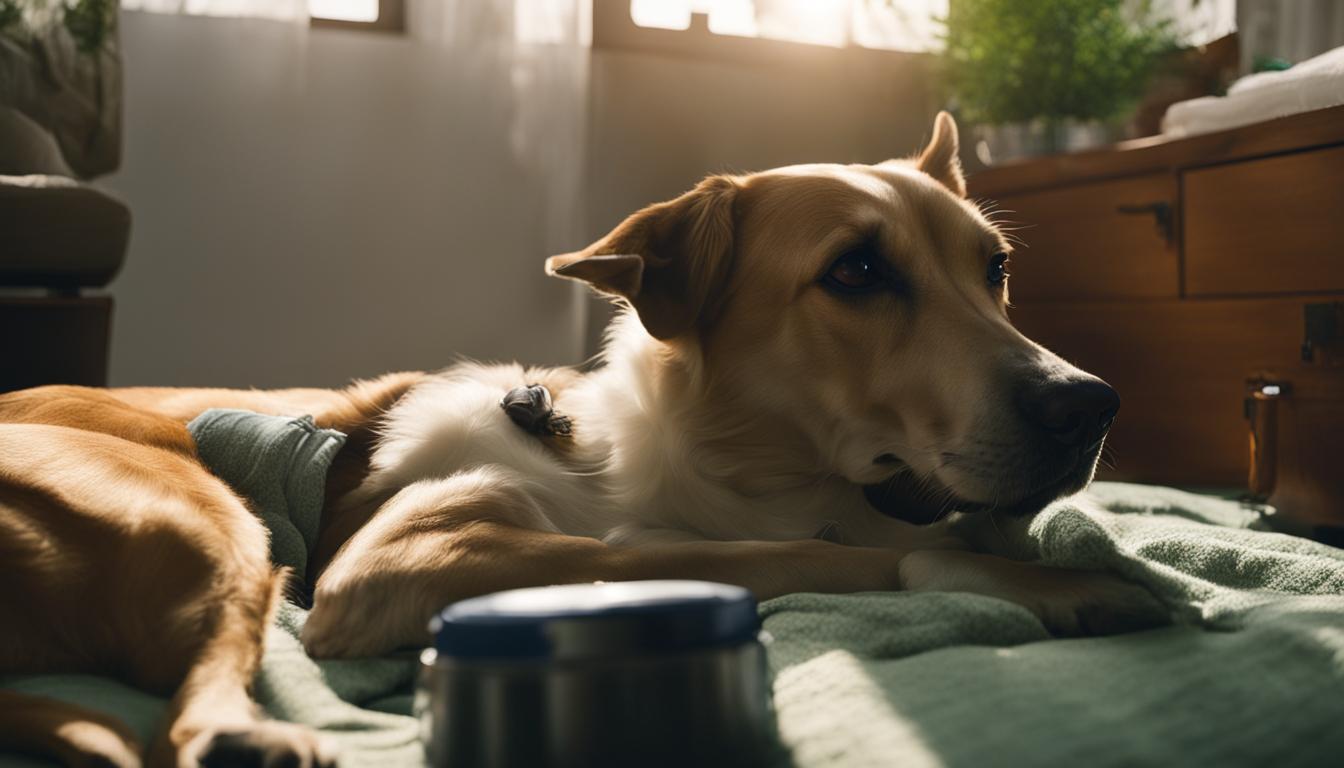Proper post-operative care is crucial for a dog’s recovery after surgery. Following your veterinarian’s instructions, managing pain, ensuring proper feeding, and providing a comfortable environment are essential for helping your dog heal.
- Follow Your Veterinarian's Post-Op Instructions
- After-Effects of General Anesthetic
- Feeding Your Dog After Surgery
- Managing Your Dog's Pain After Surgery
- Keeping Your Dog Comfortable When They Get Home
- Restricting Your Pet's Movement
- Helping Your Dog When Cage Rest is Necessary
- Caring for Your Pet's Incision Site
- Don't Skip Your Dog's Follow-Up Appointment
- Conclusion
- FAQ
- Source Links
Key Takeaways:
- Follow your veterinarian’s post-op instructions closely for the best outcome.
- Be aware of the temporary after-effects of general anesthesia, such as sleepiness and loss of appetite.
- Feeding your dog small, easily digestible meals after surgery can help stimulate their appetite.
- Properly manage your dog’s pain with prescribed medication and monitor for any adverse reactions.
- Create a calm and comfortable environment for your dog’s recovery.
Follow Your Veterinarian’s Post-Op Instructions
Proper post-operative care is crucial for your dog’s optimal recovery after surgery. One of the most important steps you can take is to closely follow the post-operative instructions provided by your veterinarian. These instructions are tailored to your dog’s specific surgery and will outline essential guidelines for their recovery.
These instructions may include information on medication administration, such as the dosage and frequency of any prescribed pain medications or antibiotics. It is important to follow these instructions carefully to ensure your dog receives the appropriate treatment and experiences relief from any discomfort or pain.
Your vet may also provide recommendations for restrictions on your dog’s activity level during the recovery period. This may involve minimizing physical exertion, avoiding strenuous exercise, and preventing your dog from jumping or running. By adhering to these guidelines, you can help prevent any complications and promote the healing process.
In addition to medication and activity restrictions, your vet may provide instructions for wound care. This can include cleaning the incision site, changing bandages, and monitoring for signs of infection. Your vet will guide you on the proper techniques and supplies needed to keep the incision site clean and protected.
Clear communication with your veterinarian is crucial throughout the recovery process. If you have any questions or concerns about the post-operative instructions, do not hesitate to seek clarification. Your vet is the best resource for guidance tailored to your dog’s specific needs and will be able to provide the necessary support for your dog’s recovery.
Follow Your Veterinarian’s Post-Op Instructions
After-Effects of General Anesthetic
After your dog undergoes surgery and receives general anesthesia, it is important to be aware of the potential after-effects that may occur. These effects are temporary and should subside within a few hours to days. It is crucial to monitor your dog closely during this time and contact your veterinarian if any concerns arise.
One common after-effect of general anesthesia is sleepiness. Your dog may appear more tired than usual and may want to sleep for extended periods. This is a normal response to the medication and surgery, and it is important to allow them to rest and recover.
Another possible effect of general anesthesia is shaking or trembling. This can occur as the anesthesia wears off and your dog’s body adjusts. It is essential to provide a warm and comfortable environment to help them feel secure and alleviate any shivering.
Loss of appetite is also common after surgery and can be a result of the effects of anesthesia. Your dog may not feel like eating for a short period, and this is typically temporary. However, it is important to monitor their food intake and contact your vet if they do not regain their appetite within a couple of days.

In summary, the after-effects of general anesthesia in dogs can include sleepiness, shaking, and temporary loss of appetite. These effects are generally normal and should subside within a few hours to days. Providing a comfortable environment and closely monitoring your dog’s recovery are essential during this time. If you have any concerns or if the after-effects persist, it is crucial to consult your veterinarian for guidance.
Feeding Your Dog After Surgery
After surgery, your dog may experience a temporary loss of appetite due to the effects of anesthesia. It is important to provide gentle care and support during this crucial recovery period. Feeding your dog appropriately can help ensure their nutritional needs are met and promote a speedy recovery.
It is recommended to start with small, easily digestible meals to entice your dog to eat. A half-size portion of a light meal, such as boiled chicken and rice, can be a great option. This combination is gentle on the stomach and provides essential nutrients for healing.
If your dog doesn’t regain their appetite within 48 hours, it is important to consult your vet. They may recommend specific dietary adjustments or further evaluation to address any underlying issues. Remember, every dog’s recovery is unique, and your vet will provide personalized guidance based on your dog’s individual needs.

Table: Sample Post-Surgery Diet Plan
| Meal | Ingredients |
|---|---|
| Breakfast | Boiled chicken breast White rice Low-sodium chicken broth |
| Lunch | Ground turkey Sweet potato Steamed green beans |
| Dinner | Salmon fillet Quinoa Steamed carrots |
As your dog’s appetite improves, gradually transition them back to their regular food. Start by mixing a small amount of their normal kibble with the post-surgery meal. Increase the ratio of regular food to the special meal over time until your dog is fully back on their regular diet.
Remember to monitor your dog’s eating habits, bowel movements, and overall behavior during the recovery process. Any changes or concerns should be promptly discussed with your vet. With proper nutrition and post-operative care, your furry friend will be on the road to a full, healthy recovery.
Managing Your Dog’s Pain After Surgery
After surgery, your dog may experience pain and discomfort as part of the healing process. Proper pain management is essential to ensure your dog’s comfort and promote a smooth recovery. Your veterinarian will prescribe pain medication specifically tailored to your dog’s needs. It is crucial to follow the dosage and administration instructions provided by your vet to effectively manage your dog’s pain.
In addition to pain medication, your vet may recommend other strategies to help alleviate your dog’s discomfort. These may include using cold packs or warm compresses on the affected area, providing soft bedding to reduce pressure on the surgical site, and minimizing physical activity to prevent further pain or injury. Providing a calm and quiet environment can also contribute to your dog’s overall comfort.
While managing your dog’s pain is important, it is equally essential to monitor for any adverse reactions to the pain medication. If you notice any signs of discomfort, such as increased lethargy, loss of appetite, or vomiting, contact your veterinarian immediately. They can provide guidance and adjust the medication if necessary.
Common Pain Medications for Dogs
Table: Common Pain Medications for Dogs
| Medication | Usage | Possible Side Effects |
|---|---|---|
| NSAIDs (Nonsteroidal anti-inflammatory drugs) | Relieve pain and inflammation | Stomach upset, kidney or liver damage with long-term use |
| Opioids (morphine, codeine, tramadol) | Manage moderate to severe pain | Sedation, constipation, respiratory depression |
| Local anesthetics | Numb specific areas for localized pain relief | Temporary numbing, allergic reactions in rare cases |
| Adjunctive analgesics | Enhance the pain-relieving effects of other medications | Varies depending on the specific medication |
It is important to note that you should never give human medications to your dog without veterinary guidance, as many medications that are safe for humans can be toxic to dogs. Be sure to communicate with your vet about any concerns or questions you may have regarding your dog’s pain management.
By effectively managing your dog’s pain after surgery, you can help them feel more comfortable and promote a faster recovery. Your veterinarian’s guidance and the proper administration of pain medication will play a crucial role in ensuring your dog’s well-being during the healing process.
Keeping Your Dog Comfortable When They Get Home
After surgery, it is crucial to create a comfortable and calming environment for your dog’s recovery. By providing the right conditions, you can promote healing, reduce stress, and ensure a smoother transition back to their normal routine. Here are some essential tips for keeping your dog comfortable when they get home:
- Create a cozy space: Set up a quiet and spacious area for your dog to rest. Use a soft bed or cushion to provide comfort and prevent pressure on sensitive areas. This will help alleviate any discomfort and encourage relaxation.
- Minimize stress: Keep your dog away from children, other pets, and excessive noise or activity. Minimizing external stimuli will reduce anxiety and allow your dog to focus on healing.
- Provide gentle support: Offer gentle physical support, such as assisting your dog when they need to stand or lie down. This can help them feel secure and prevent any accidental strain on their surgical site.
Remember, each dog is unique, and their preferences may vary. Observe your dog’s behavior and adjust their environment accordingly. By prioritizing their comfort, you can contribute to their overall well-being during the recovery process.
Testimonial
“Creating a peaceful and comfortable space for my dog after his surgery made a significant difference in his recovery. He was able to rest without distractions and seemed less anxious overall. I highly recommend focusing on your dog’s comfort to support their healing journey.”
– Dog Owner, Sarah
Remember, each dog is unique, and their preferences may vary. Observe your dog’s behavior and adjust their environment accordingly. By prioritizing their comfort, you can contribute to their overall well-being during the recovery process.
Restricting Your Pet’s Movement
After surgery, it is crucial to restrict your pet’s movement to ensure proper healing. Your veterinarian may recommend limiting activity and preventing jumping or stretching that could interfere with the recovery process. By following these guidelines, you can help prevent complications and facilitate a smooth recovery.
Why restricted activity is important
Restricted activity allows your pet’s body to focus on healing without unnecessary strain. Movement restrictions can prevent the reopening of incisions, minimize pain, and reduce the risk of post-operative complications. It is vital to follow your veterinarian’s instructions regarding the duration and level of activity restriction for your pet.
Here are some tips to help you restrict your pet’s movement:
- Create a safe and confined space for your pet, such as a small room or a crate. This will prevent them from wandering or engaging in activities that may hinder the healing process.
- Use a leash during supervised walks to control the intensity and duration of exercise.
- Provide mental stimulation through interactive toys or puzzles, as physical activity may be limited.
- Ensure your pet’s environment is free from obstacles or hazards that could lead to accidental injuries.
By implementing these measures, you can help your pet recover safely and efficiently from their surgery. Remember to consult your veterinarian if you have any concerns or questions about restricting your pet’s movement.
| Restricted Activity Tips | Benefits |
|---|---|
| Create a confined space | Prevents wandering and interference with healing process |
| Use a leash for controlled walks | Controls intensity and duration of exercise |
| Provide mental stimulation | Compensates for limited physical activity |
| Ensure a safe environment | Reduces the risk of accidental injuries |
Helping Your Dog When Cage Rest is Necessary
When your dog requires cage rest after surgery, it’s important to provide them with the necessary support and care to help them adjust to this temporary lifestyle. Crate confinement can be challenging for both you and your furry friend, but with a few simple steps, you can make the experience as comfortable as possible.
First, ensure that the crate is spacious enough for your dog to stand, sit, and lie down comfortably. It should provide enough room for them to move around without feeling cramped. Adding soft bedding, such as a comfortable blanket or a dog bed, can also help create a cozy environment.
Additionally, consider providing mental stimulation and entertainment for your dog during their crate rest. Interactive toys, puzzle feeders, or treat-dispensing toys can keep them occupied and prevent boredom. This not only helps ease their frustration but also promotes mental engagement.
Remember to schedule regular potty breaks for your dog while they are in their crate. Set a consistent routine for bathroom breaks outside, ensuring they have plenty of time to relieve themselves and stretch their legs. Additionally, if your dog requires medication during their crate rest, make sure to administer it as prescribed by your veterinarian.
| Tips for Helping Your Dog Adjust to Crate Rest | |
|---|---|
| 1. Gradual Introduction: | Introduce your dog to the crate gradually, allowing them to explore it at their own pace. Use positive reinforcement, such as treats and praise, to create a positive association with the crate. |
| 2. Regular Exercise: | Although your dog’s movement may be restricted, it’s important to provide regular exercise within the confines of the crate. Simple stretching exercises and gentle physical activities can help prevent muscle stiffness and promote overall comfort. |
| 3. Contact with Family: | Keep your dog’s crate in an area where they can still see and interact with family members. This helps reduce feelings of isolation and anxiety. |
| 4. Calming Techniques: | Try using calming techniques, such as soothing music or pheromone diffusers, to help create a calm and relaxing atmosphere for your dog during their crate rest. |
“Crate rest can be challenging for dogs, but with your love and support, they will adjust in time and heal properly. Remember to consult with your veterinarian for specific guidelines and advice tailored to your dog’s individual needs.”
By following these tips and providing a nurturing environment, you can help your dog navigate the temporary confinement of crate rest with ease. Patience and understanding are key as your dog heals and recovers, and soon enough, they will be back to their active and happy selves.
Caring for Your Pet’s Incision Site
Proper care of your pet’s incision site is crucial for ensuring a successful recovery after surgery. By taking necessary precautions, you can prevent complications and promote healing. Here are some essential tips to help you care for your pet’s incision site:
- Prevent licking and scratching: Your pet may be tempted to lick or scratch the incision site, which can lead to infection or delays in healing. Use a cone-shaped collar or alternative options recommended by your vet to prevent your pet from bothering the wound.
- Keep the area clean and dry: It’s important to keep the incision site clean and free from moisture. Avoid bathing your pet until your veterinarian gives the green light. If the wound gets dirty, gently clean it with a sterile saline solution or as advised by your vet.
- Monitor for signs of infection: Regularly inspect the incision site for any signs of infection, such as redness, swelling, discharge, or a foul odor. If you notice any of these symptoms, contact your veterinarian immediately.
- Follow your vet’s instructions: Your veterinarian will provide specific instructions for caring for your pet’s incision site. Follow these instructions carefully, including any recommended wound dressings or medications. If you have any questions or concerns, don’t hesitate to reach out to your vet.
Remember, proper wound care is crucial for your pet’s recovery. By taking proactive steps to prevent licking, keeping the area clean, and monitoring for signs of infection, you can help your pet heal properly and minimize the risk of complications.
| Signs of Infection | What to Do |
|---|---|
| Redness, swelling, or discharge | Contact your veterinarian immediately |
| Foul odor | Contact your veterinarian immediately |
Don’t Skip Your Dog’s Follow-Up Appointment
After your dog undergoes surgery, it’s important not to overlook the significance of follow-up appointments. These appointments provide your veterinarian with an opportunity to assess your dog’s healing progress and address any potential concerns or complications that may arise. By attending these appointments, you can ensure that your dog receives the necessary care and attention for a successful recovery.
During follow-up visits, your vet will conduct thorough examinations of your dog’s incision site and perform any needed bandage changes. This helps to prevent infections and ensures that the wound is healing properly. Additionally, your vet may adjust pain medication dosages if necessary and provide guidance on transitioning back to your dog’s regular diet and exercise routine.
Regular communication with your veterinarian is key to the success of the follow-up appointments. It is important to share any observations or concerns you have about your dog’s recovery progress. Your vet can offer guidance and reassurance, addressing any questions or uncertainties you may have. By following their instructions and recommendations, you can optimize your dog’s recovery and help them return to their normal, active lifestyle as quickly as possible.
| Benefits of Follow-Up Appointments for Your Dog |
|---|
| 1. Monitoring healing progress and addressing complications |
| 2. Conducting necessary bandage changes and wound care |
| 3. Adjusting pain medication dosages if needed |
| 4. Providing guidance on diet and exercise during recovery |
| 5. Addressing any concerns or uncertainties |
By prioritizing follow-up appointments, you are actively participating in your dog’s recovery process. These appointments not only facilitate the healing of your dog’s incision site but also help to prevent potential complications. Remember, your veterinarian is your trusted partner in your dog’s journey to recovery, and regular follow-up appointments play a crucial role in ensuring the best possible outcome.
Conclusion
Proper care after surgery is vital for your dog’s recovery. By following your veterinarian’s instructions, managing pain, providing comfort, and monitoring the incision site, you can ensure the best outcome for your furry friend.
Remember that each dog’s recovery time may vary, depending on the type of surgery. Some dogs may bounce back quickly, while others may require more time and attention. Be patient and give your dog the care they need during this healing process.
By offering a calm and comfortable environment, following feeding guidelines, and administering prescribed medication, you can help your dog regain their strength and get back to their normal, active lifestyle.
Remember, your veterinarian is your best resource for guidance and support during your dog’s recovery. Don’t hesitate to reach out to them with any questions or concerns. With proper care and love, your dog will be on the path to a successful surgery recovery.
FAQ
What should I do after my dog has surgery?
It is crucial to closely follow the post-operative instructions provided by your veterinarian. These instructions will include guidance on medication administration, restrictions on activity, and wound care.
What are the common after-effects of general anesthesia on dogs?
General anesthesia can have temporary effects on your dog, such as sleepiness, shaking, and loss of appetite. These effects should subside within a few hours to days.
How can I help my dog regain their appetite after surgery?
Following surgery, your dog may have a decreased appetite due to the effects of anesthesia. It is recommended to offer a half-size portion of a light meal, such as chicken and rice, which is easy to digest. Gradually transition back to their regular food once their appetite returns.
What pain medication should I give my dog after surgery?
Your vet will prescribe pain medication to manage your dog’s post-surgery pain. Follow the instructions provided for dosage and administration. Never give human medications to your dog without veterinary guidance as they can be toxic.
How can I create a comfortable environment for my dog to recover?
Create a comfortable and quiet space for your dog to rest after surgery. Use a soft, spacious bed to prevent pressure on sensitive areas. Keep your dog away from children and other pets to minimize stress.
Should I restrict my dog’s movement after surgery?
Your vet may recommend limiting your dog’s movement after surgery to promote proper healing. Prevent jumping and stretching that could interfere with the recovery process. Confining your dog to a safe room or using crate rest may be necessary.
What should I do to care for my dog’s incision site?
Prevent your dog from biting, chewing, or scratching the incision site or bandages. Use a cone-shaped collar or alternative options recommended by your vet to protect the wound. Keep bandages dry and clean, covering them during outdoor activities.
How important are follow-up appointments after surgery?
Regular follow-up appointments allow your vet to assess your dog’s healing progress and address any potential issues. Proper bandage changes and wound care can be done during these visits. Maintain open communication with your vet and adhere to their instructions for the best outcome.
Source Links
- https://www.atlanticcoastvet.com/site/blog-long-island-vet/2021/12/15/helping-your-dog-recover-after-surgery
- https://www.papayapet.com/resources/how-to-help-your-dog-recover-after-surgery/
- https://www.huntersville.carolinavet.com/site/huntersville-veterinary-blog/2020/08/04/caring-for-dog-after-surgery




